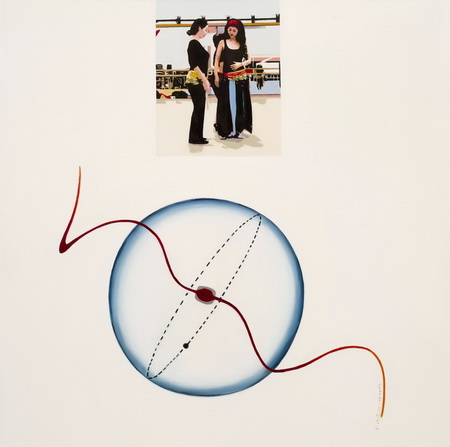
▲ 陈燕子《云彩NO·30》;150cm×150cm;布面油画;2017
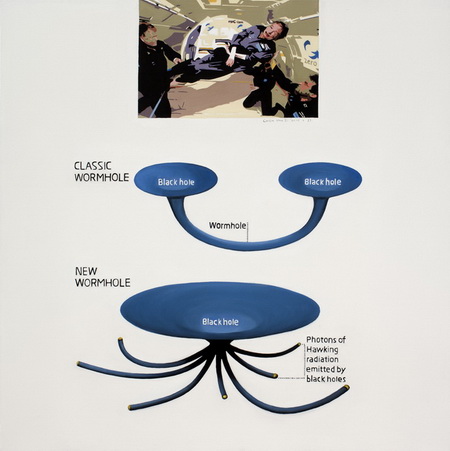
▲ 陈燕子《云彩NO·26》;150cm×150cm;布面油画;2016
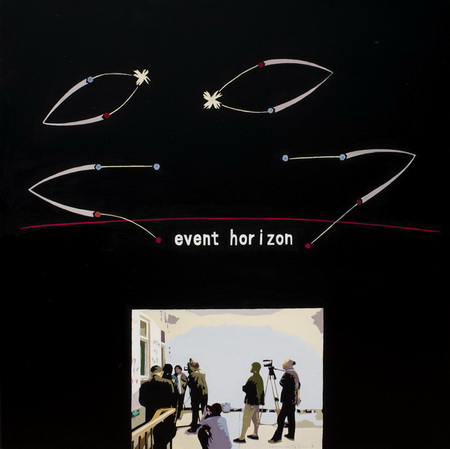
▲ 陈燕子《云彩NO·29》;150cm×150cm;布面油画;2016
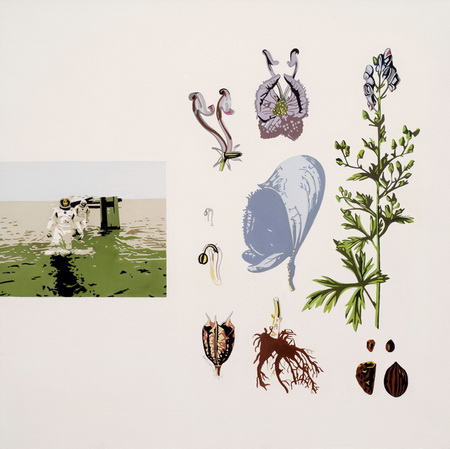
▲ 陈燕子《云彩NO·28》;150cm×150cm;布面油画;2016
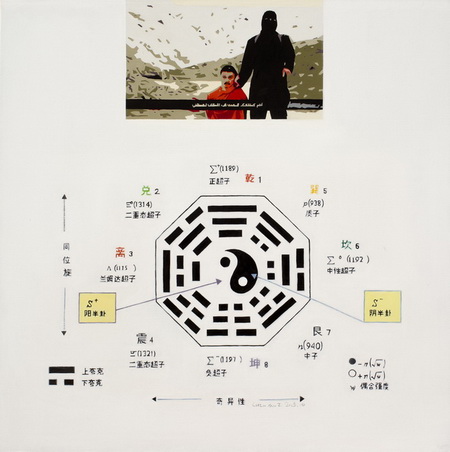
▲ 陈燕子《云彩NO·27》;150cm×150cm;布面油画;2015
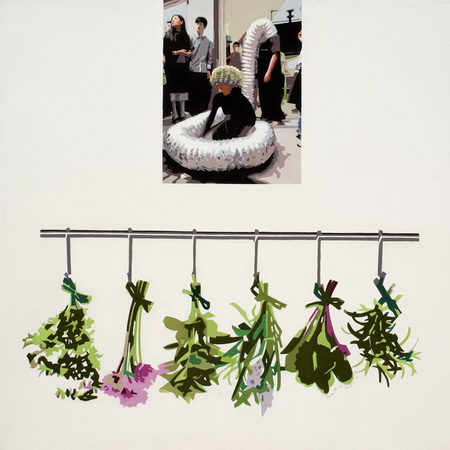
▲ 陈燕子《云彩NO·25》;150cm×150cm;布面油画;2015
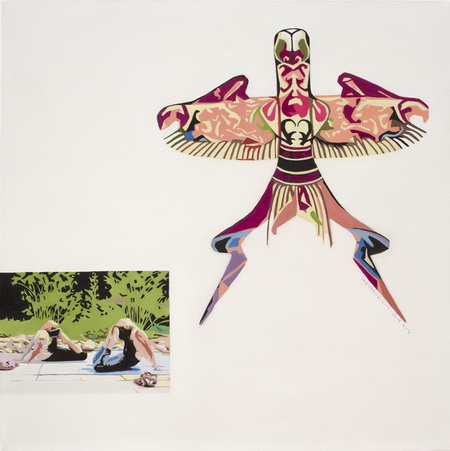
▲ 陈燕子《云彩NO·24》;100cm×100cm;布面油画;2012-2015
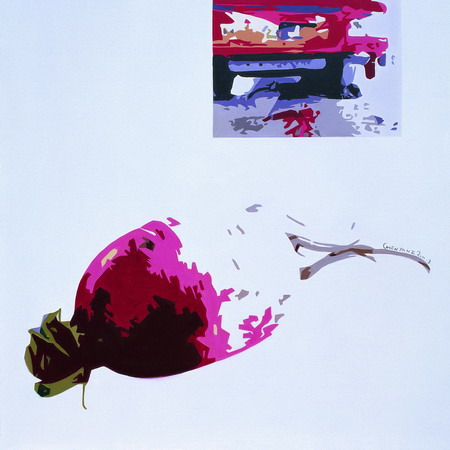
▲ 陈燕子《云彩NO·8》;130cm×130cm;布面油画;2011年
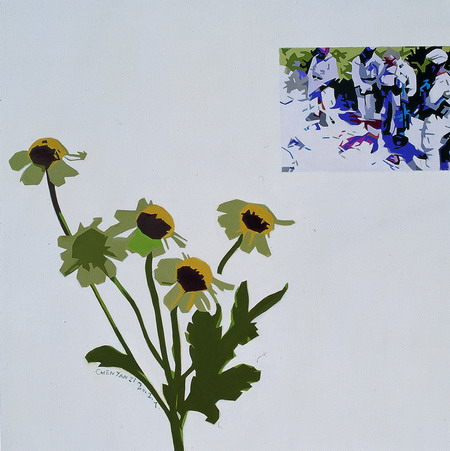
▲ 陈燕子《 云彩NO·23》;100cm×100cm ;布面油画;2012年;陈燕子
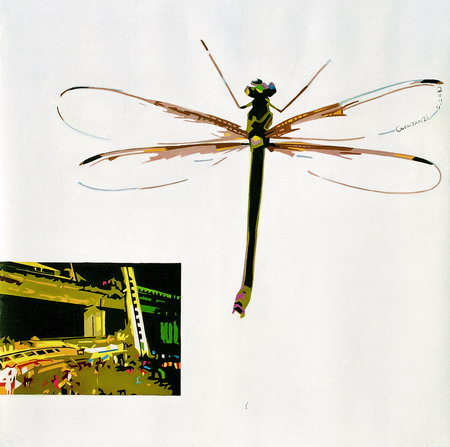
▲ 陈燕子《云彩NO·17》;100cm×100cm ;布面油画;2011年

▲ 陈燕子《云彩NO·3》;100cm×100cm;布面油画;2009年
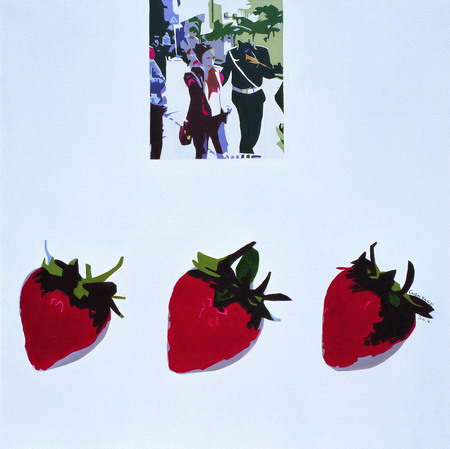
▲ 陈燕子《云彩NO·11 》;130cm×130cm ;布面油画;2011年
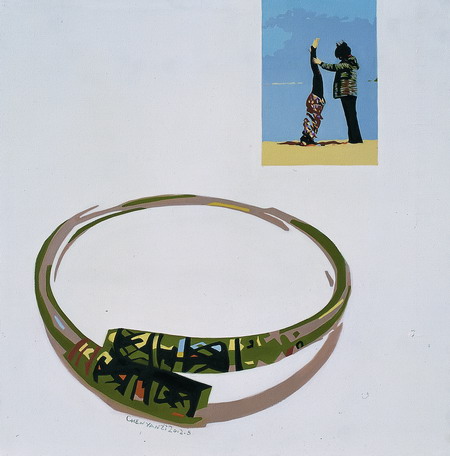
▲ 陈燕子《云彩NO·20 》;100cm×100cm;布面油画;2012年
物观 • 观悟
——陈燕子作品个案分析
文︱张海涛
很多人第一眼见到燕子,觉得她是个开朗快乐的小女人,时尚而物质,个性而罗曼蒂克;其实不然,接触时间长了才发现她内心更多的是悲观、敏感和细腻,这种双重性格中它更倾向于后者。她时常为一段记忆或情感而感伤流泪,对生命情感与对物的冲动表现出心灵的摇摆与失落。这也是七十年代青年的内心写照,与物质现实的感应和对精神朴素的向往,这样的双重性格是燕子个人特殊的内心成长经历和现实浸染形成的。燕子作品中表现出对物这个永恒体的当代性思考和体验,具有小时代里“颗粒”似的人生观。燕子作品对生命的物观,我更喜欢理解为她通过个人内心碎片诠释永恒性的物观,而非个人私密的小情节。作者冥想着当下人与当下物的关系,透过“颗粒、云彩”隐藏着对物象的凝固和偏执的感悟。她的作品也通过不同的阶段“记忆物象”、“生存寓言”、“社会实证”不断地走出自我,关注更大、更实际的人文事物,通过贯穿的物象消解人类的欲望,从而改变我们的心境。
燕子作品中的图式如我们儿时看图说话,摆事实讲道理,一物一人、一人一景或一事一物,将画面切分为二,在作品中燕子特殊地放大了物的比例,缩小了人的尺度,这是一个有意思的事情,让我们对于人与物的关系产生了新的思考。画面的人、物构成,限于两个画面,也是一种有意思的尝试,我设想了一幅画一个图或一幅画多个图,都达不到这样的物化关系,这种人的生活碎片与物的“生硬”对照,将两者似乎没有关系的事物产生了异样的关系,应证着这样的一个哲理:世界上很多看似没有关系的事物,却有着一定的“联系”,这样的关系美学产生什么样的感觉,是作品的关键的价值支点,同时也取决于“选择”什么样的人或什么样的物,这种关系自动突显的观念,需与观众共鸣得到,交给观众感应,也与观众产生了静态的互动,这就是作品想达到的效果。选择即为一种艺术价值的判断,选择也决定一种态度、眼光和价值标准。在我们这个类像丛生的信息时代,很多类像随时大量转载、剪辑、发送,这时选择与转换也即一种艺术。一个事物的选择是艺术家的修养和综合能力的体现。对照图式及色彩的朴素语言,透析着画面中作品的非修饰、自然的潜默力量,更是作者“观物”心境的表达。
燕子作品从生存感悟、关注的题材上分为“颗粒”系列和“云彩”系列。
燕子作品《颗粒》系列第一阶段绘画语言以黑白灰为主色调。作品中对于作品名称“颗粒”的理解与物有着一致的感觉,同时有着双重的意思,颗粒即人与物的寓体,“颗粒”本身就有一种微小和弱势的感伤特性。
《颗粒》系列画面第一阶段是物与人的选择与并置,主要是身边的家人和朋友的生活记忆场景与对应的物产生的寓言关系。如果说时间是记录微观和宏观的情感本源,我们认识燕子的作品之时,这个七零后艺术家必定会回忆她的小时代,这个时代记忆中传达给我们的生存感受,即带有七零后的时代特征。
时间与物的变化,是永恒的自然物态,这也是不以人的意志为转移的。朋友盖房子、海边游泳、妹妹的瑜伽生活与对应的物象……这些生存环境带给我们的不论是快乐和苦涩终极都会消逝,记忆物象的时空感带给我们的感伤是艺术家表达情感的一个愿望。燕子作品中的题材以物与人的对照语言来进行的思想转换,也给记忆带来了个性新鲜的感觉。
《颗粒》系列的第二个阶段作品中的人与物都是网络上下载的,这时作品的物象走出身边私人化记忆,表现公共或虚拟的人与物的关系。这个阶段作品更多是“当下人”的生存寓言和感悟。艺术的当代性在于把当下的生存感受与永恒的寓言嫁接,给我们以新的启示。在表现这些寓言时多采用不现实的手法,让这个世界产生强烈的寓意,这样画面不相干事物潜意识的并置,产生的静止而神秘感给我们述说着生存的道理,也是将永恒哲理的当代化转换。
人——稚气儿童、时尚的女性、幸福的老人和异化的生活片段;物——象征男性力量的物(如钳具、刀具)、朴素自然的物(如桶、筐、鞋、油灯)和女性时尚消费品(如咖啡机、化妆品、围巾),这些人、物的选择和对照有一种网络快照截取的凝固,有一种宿命轮回感和浮华背后自然原始动力带给我们的思考,这是燕子的作品中呈现的感觉,也是她对“人”的思考:人最终都会走向物化,面对物化的态度更为重要。
如果说记忆物象的“颗粒”适合于黑白灰的色调,那么“云彩”系列有了丰富的色彩语言,“云彩”有种不确定的浪漫主义,也是一种逍遥的心态。燕子作品的这个阶段关注的物象更拉近了物与现实的关系,我称为艺术的社会实证。作品强调艺术家以社会学者的身份介入现实,以社会学视角对现实社会介入的态度很重要。画面中郭美美、钱云会和凤姐等等事件揭示了乱象的价值观,以真诚的良知揭示真相,由外及里的为艺术提供参考的文化背景。这样的作品避免了当代艺术作品中普遍存在的概念空洞的点子化现象。
燕子作品中的符号和色彩不论怎么变化,然而物象的对应是她作品语言贯穿的线索,这些物象是在消解人的欲望,也希望自己能看淡一切。人类对于物观的思考从来没有放弃过脚步,除了世界各类宗教都谈到拯救精神物化的问题,各个时代的思想家也对物的关注和对其文化针对性的探讨不同:如庄子“齐物论”、佛教的“格物”、马克思的“唯物”、存在主义的物和日本的物派……物观不同与东西方差异有关,更与“此时此刻的存在”有关,这也是艺术家应该探索的问题。燕子作品中人、物对照的语言图式很突出,她对于人、物的选择和这两个符号之间的关系的把握一直在努力的探索,我们对她新的作品也充满着期待。
2008年3月8日于通州
2012年7月28日稍作修改
Object Observation and Insight
— Case Study of Chen Yanzi's Works
By Zhang Haitao
At first glance, many people perceive Yanzi as a cheerful, happy little woman who is fashionable and materialistic, individualistic, and romantic. However, this is not the case. Upon prolonged contact, one discovers that her inner world is more悲观, sensitive, and delicate, tending towards the latter of these dual personalities. She often weeps sentimentally over a memory or emotion, displaying a swaying and lost heart concerning life's affections and impulses towards objects. This reflects the inner life of youth born in the 1970s, their resonance with material reality, and their yearning for spiritual simplicity. Yanzi's dual personality is shaped by her unique inner growth experiences and immersion in reality. Her works exhibit contemporary reflections and experiences of objects as eternal entities, embodying a "grained" outlook on life in the small era. When viewing Yanzi's object-oriented perspective on life, I prefer to understand it as her interpretation of the eternal perspective of objects through personal inner fragments, rather than as personal intimate vignettes. The artist contemplates the relationship between contemporary people and objects, concealing her frozen and obsessive insights into objects through "grains" and "clouds." Her works also continuously transcend the self through different stages of "remembered objects," "survival fables," and "social empiricism," focusing on larger and more practical humanistic issues. By disseminating objects throughout, her works dissipate human desires, thereby transforming our state of mind.
The iconography in Yanzi's works resembles how we described pictures in our childhood, presenting facts and reasoning, pairing one object with one person, one person with one scene, or one event with one object. The paintings are divided into two parts. In her works, Yanzi uniquely enlarges the proportion of objects and shrinks the scale of humans, which is an intriguing aspect that prompts us to reconsider the relationship between humans and objects. The composition of humans and objects in the paintings, confined to two scenes, is also an interesting experiment. I envision that either a single image or multiple images in one painting would fail to achieve such an objectified relationship. The juxtaposition of the fragments of human life and the "harsh" objects creates an unusual connection between seemingly unrelated things, affirming the philosophy that many things in the world that appear unrelated actually have a certain "connection." The aesthetic of such relationships generates certain sensations, which is a crucial value fulcrum of the works. It also depends on the choice of what kind of person or object is selected. The concept of such relationships automatically emerges and resonates with the audience, creating a static interaction with them. This is the effect that the works aim to achieve. Choice represents a judgment of artistic value, determining an attitude, perspective, and value standard. In our information age filled with simulacra, many simulacra are constantly reprinted, edited, and sent. At this time, selection and transformation also constitute an art form. The choice of a subject matter reflects an artist's cultivation and comprehensive abilities. The plain language of the iconography and colors reveals the unadorned, natural, and silent power of the works, expressing the artist's mindset in observing objects.
Yanzi's works are divided into the "Grains" series and the "Clouds" series based on her insights into existence and the themes she focuses on.
The first phase of Yanzi's "Grains" series primarily uses black, white, and gray as its color palette. The understanding of the title "Grains" shares a consistent sensation with objects and carries a dual meaning. Grains serve as the embodiment of both humans and objects, inherently possessing a trait of minuteness and vulnerability that evokes sadness.
The first stage of the "Grains" series involves the selection and juxtaposition of objects and humans, mainly depicting allegorical relationships between life memories of family members and friends and corresponding objects. If time is the source of emotions that record the micro and macro, when we encounter Yanzi's works, this artist born in the post-1970s will inevitably recall her small era. The survival sensations conveyed to us from this era's memories bear the characteristics of the post-1970s generation.
The changes in time and objects constitute an eternal natural state, which is independent of human will. Building a house with friends, swimming at the seaside, a sister's yoga life, and corresponding objects—whether the joy or bitterness derived from these living environments will ultimately dissipate. The temporal and spatial sense of remembered objects brings about a sentimentality that is an aspiration for the artist to express her emotions. The thematic conversion through the contrasting language of objects and humans in Yanzi's works also brings a fresh and individualistic sensation to memories.
In the second phase of the "Grains" series, the humans and objects depicted are downloaded from the internet. At this stage, the objects in the works move beyond personal memories, representing the relationships between public or virtual humans and objects. These works are more about the survival fables and insights of "contemporary people." The contemporaneity of art lies in the grafting of contemporary survival sensations onto eternal fables, providing us with new enlightenment. Unrealistic techniques are often employed when expressing these fables, imparting a strong moral to the world. The juxtaposition of unrelated objects in the paintings creates a static and mysterious sensation that tells us the truths of survival. It also converts eternal philosophies into contemporary forms.
Humans—naive children, fashionable women, happy elderly people, and alienated life fragments; objects—symbols of male strength (such as pliers and knives), plain and natural objects (such as buckets, baskets, shoes, and oil lamps), and female fashion consumer goods (such as coffee machines, cosmetics, and scarves). The selection and juxtaposition of these humans and objects have a凝固 akin to a snapshot from the internet, evoking a sense of fatalistic recycling and thoughts provoked by the natural primitive force behind vanity. This is the sensation presented in Yanzi's works and her contemplation on "humans": humans will ultimately become materialized, and the attitude towards materialization is more crucial.
If the "grains" of remembered objects suit a black, white, and gray palette, then the "Clouds" series boasts a rich color language. "Clouds" embody an uncertain romanticism and a carefree mindset. At this stage, the objects of focus in Yanzi's works draw a closer relationship between objects and reality, which I refer to as social empiricism in art. The works emphasize the artist's intervention in reality as a sociologist, and it is crucial to adopt a sociological perspective towards attitudes towards engaging with contemporary society. Images of events such as Guo Meimei, Qian Yunhui, and Sister Feng in the paintings reveal chaotic values, revealing the truth with sincere conscience and providing a cultural background for art from the outside in. Such works avoid the common phenomenon of conceptually hollow, idea-driven works prevalent in contemporary art.
Regardless of how the symbols and colors in Yanzi's works change, the correspondence of objects serves as the thread running through her artistic language. These objects dissipate human desires and reflect the artist's wish to take everything lightly. Humans have never ceased pondering the perspective of objects. Besides various religions worldwide discussing the salvation of spiritual materialization, thinkers of various eras have also focused on objects and explored their cultural pertinence differently: such as Zhuangzi's "Theory of the Equality of Things," Buddhist "investigation of things," Marx's materialism, existentialist objects, and Japan's Mono-ha. Differences in object perspectives are related to East-West distinctions, but more so to the "existence of the here and now," which is an issue artists should explore. The linguistic iconography of the juxtaposition of humans and objects in Yanzi's works is prominent. She has been diligently exploring the selection of humans and objects and the grasp of the relationship between these two symbols. We eagerly anticipate her new works.
Written in Tongzhou on March 8, 2008
Slightly revised on July 28, 2012
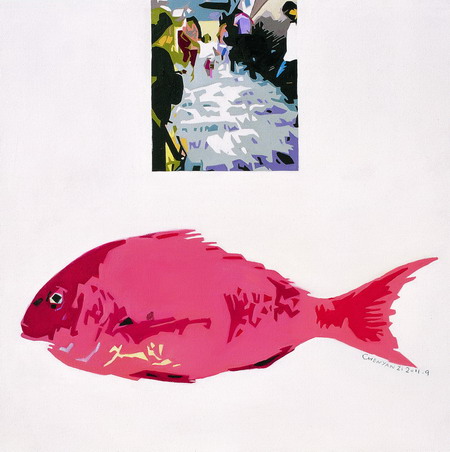
▲ 陈燕子《 云彩NO·16》; 100cm×100cm;布面油画;2011年
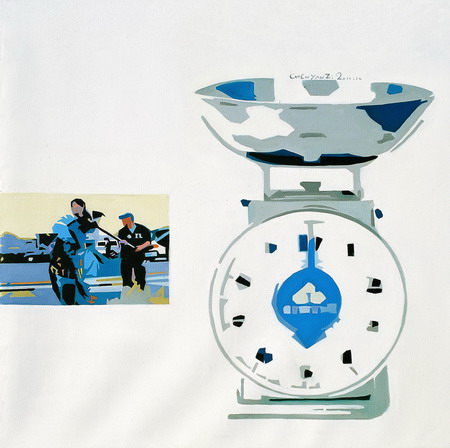
▲ 陈燕子《云彩NO·15 》;00cm×100cm;布面油画;2011年
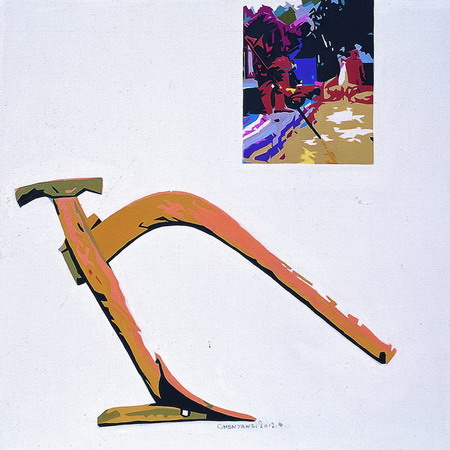
▲ 陈燕子《云彩NO·21》;100cm×100cm;布面油画;2012年
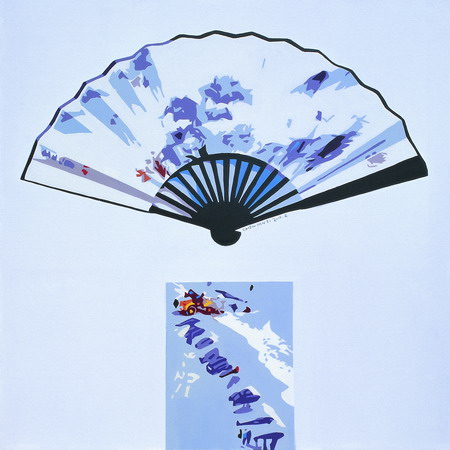
▲ 陈燕子《云彩NO·12》;130cm×130cm;布面油画;2011年
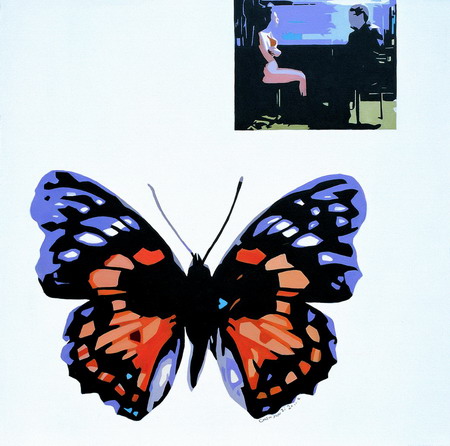
▲ 陈燕子《云彩NO·9 》;130cm×130cm;布面油画; 2011年
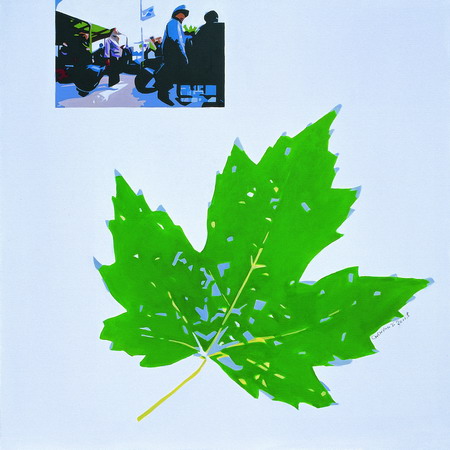
▲ 陈燕子《云彩NO·10 》;130cm×130cm;布面油画; 2011年
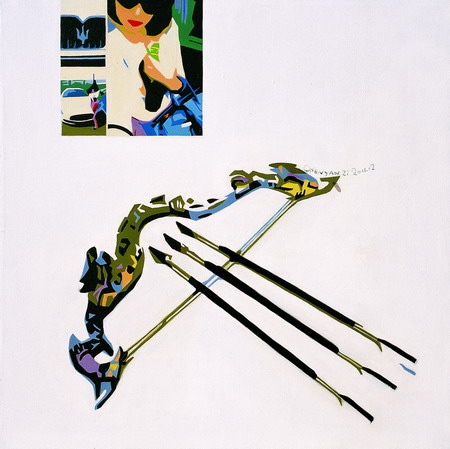
▲ 陈燕子《云彩NO·18》;100cm×100cm;布面油画;2011年
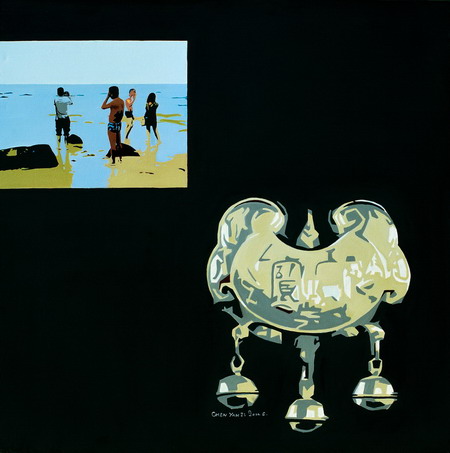
▲ 陈燕子《在海边》;130cm×130cm;布面油画;2010年
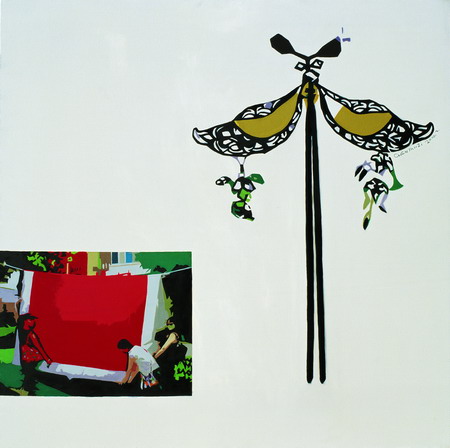
▲ 陈燕子《晒被子》;130cm×130cm;布面油画;2010年
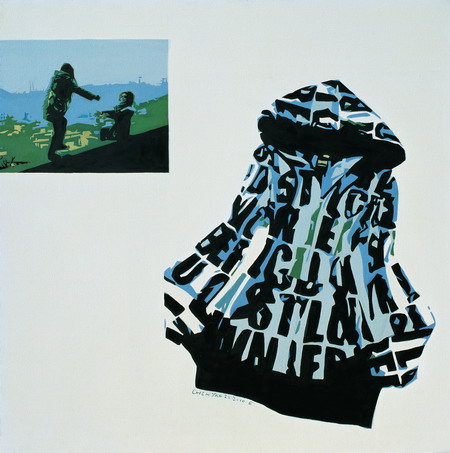
▲ 陈燕子《有危险》130cm×130cm;布面油画;2010年
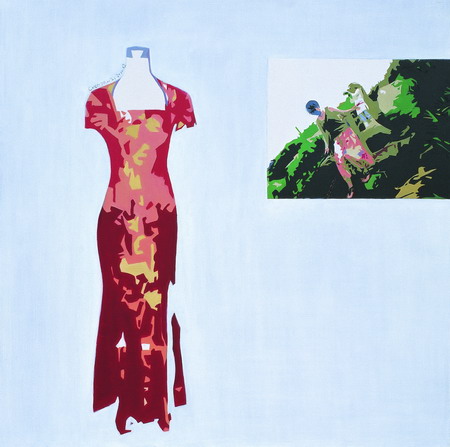
▲ 陈燕子《下山难 》;130cm×130cm;布面油画 ;2010年
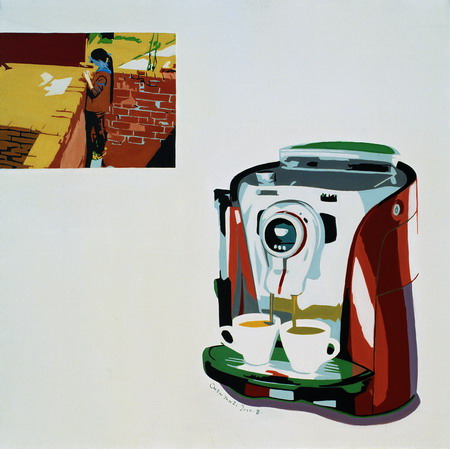
▲ 陈燕子《盖新房》;130cm×130cm;布面油画; 2010年

▲ 陈燕子《云彩NO·5》100cm×100cm; 布面油画;2009年
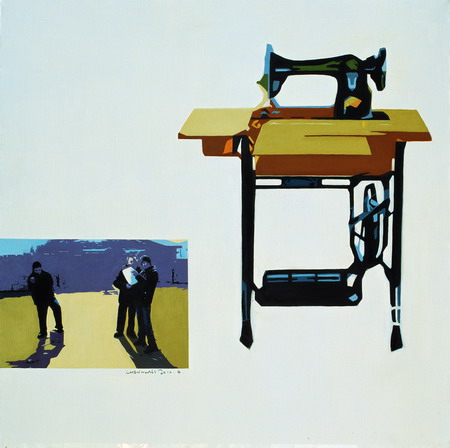
▲ 陈燕子《云彩NO·6》;150cm×150cm ;布面油画;2010年

▲ 陈燕子《云彩NO·1》;100cm×100cm;布面油画;2009年
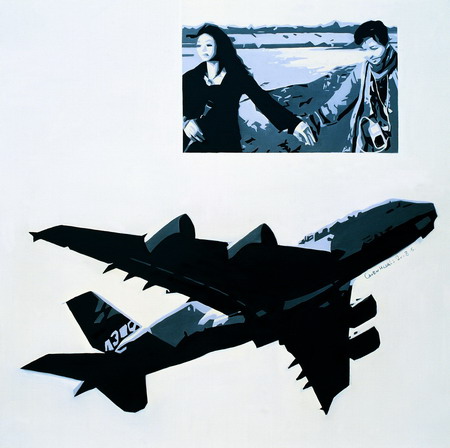
▲ 陈燕子《颗粒NO·16 》;150cm×150cm;布面油画;2008年
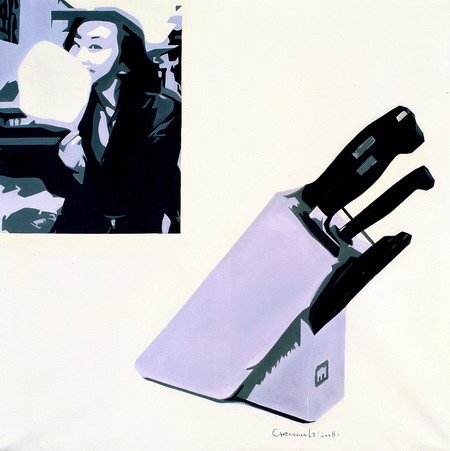
▲ 陈燕子《颗粒NO·11》;150cm×150cm;布面油画;2008年
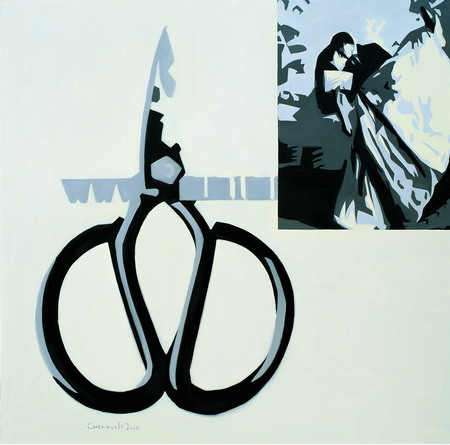
▲ 陈燕子《颗粒NO·14 》;150cm×150cm;布面油画;2008年
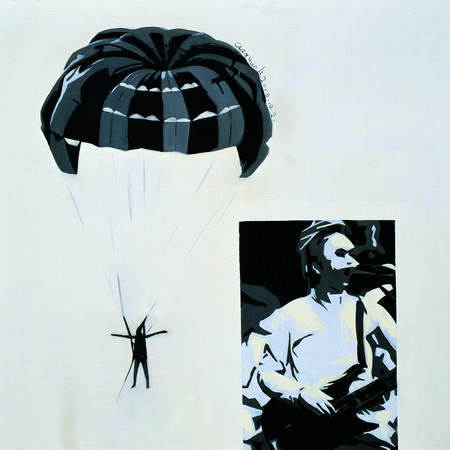
▲ 陈燕子《颗粒NO·25》;100cm×100cm;布面油画;2008年
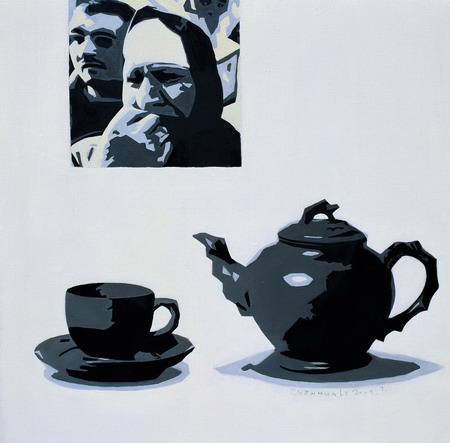
▲ 陈燕子《颗粒NO·18》;100cm×100cm ;布面油画;2008年
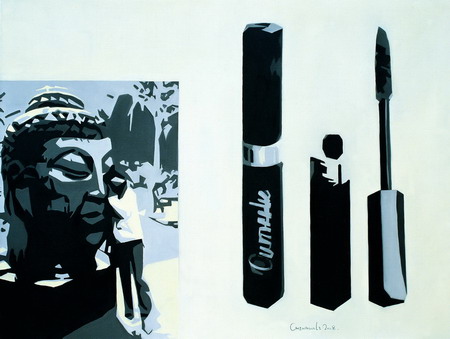
▲ 陈燕子《颗粒NO·12》;200cm×150cm;布面油画;2008年

▲ 陈燕子《颗粒NO·20》;100cm×100cm;布面油画;2008年
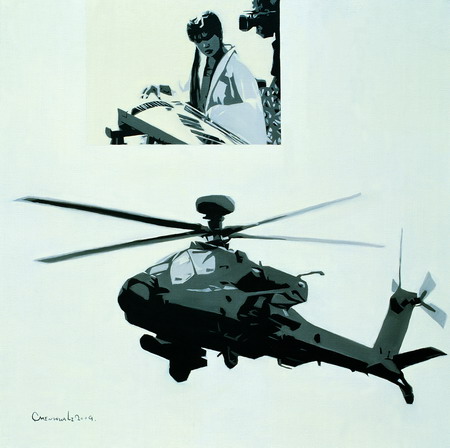
▲ 陈燕子《颗粒NO·27》;100cm×100cm;布面油画;2009年
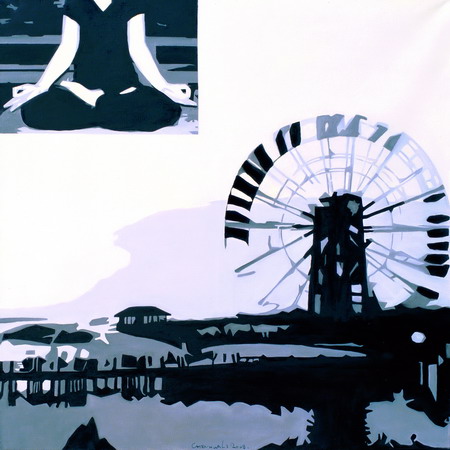
▲ 陈燕子《颗粒NO·9》;50cm×150cm;布面油画;2008年
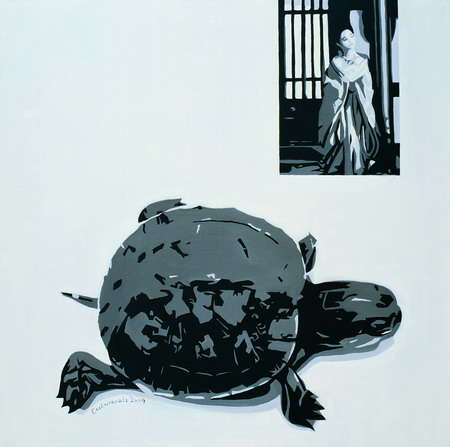
▲ 陈燕子《颗粒NO·29》;100cm×100cm;布面油画;2009年
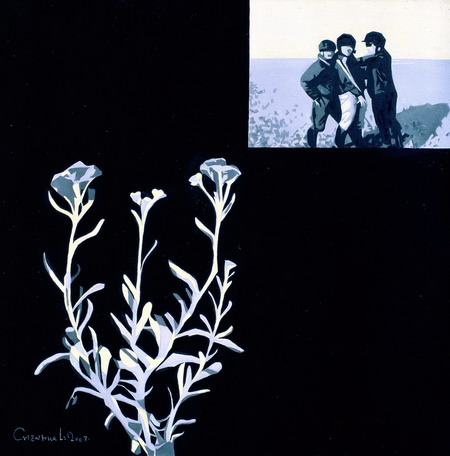
▲ 陈燕子《颗粒NO·4》;100cm×100cm;布面油画;2007年
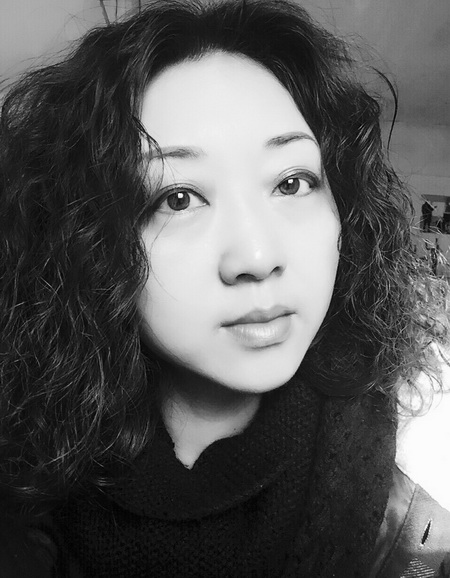
陈燕子(Chen Yanzi)
艺术简历
陈燕子(原名:陈华莉)出生于湖北宜昌;学习于湖北美术学院。从事当代艺术架上绘画创作、艺术档案网执行主编工作至今。现居中国·宋庄。
曾参加:2021年 “中和”、“浮岚暖翠”;2019年 “斩新飞行”;2016年UCCA“世界临终关怀与缓和医疗日:中国2016艺术行动;2013年“另一种纪录”、“各自为政”、“长城的纬度,国际的维度”当代艺术双年展、“115位艺术家的自画像”、“回到叙事性”、“理智与情感”;2012年“形·势”、“文化·沙漠”库布其当代艺术展;2011年“历史·新宋庄”;2010年“双重语境”;2009年“群落!群落”;2008年“她们!她们”、“生活在宋庄·女性版”、“一·一”当代艺术展、“形色各异”;2006年“13个同学”等展览。
不以物喜,不以己悲
——我的布面油画《颗粒》+《云彩》创作手记
某些时候,艺术是“谈”不出来的,它是一个漫长的甚至需要人的一生潜心学习与“润物无声”的实践过程。生活状态对我才是最重要的。
兜兜转转,在远离喧嚣的北京乡村(中国·宋庄)→_→如今的乡村已华丽转型为北京城市副中心重要组成部分→_→根据北京城市副中心的规划,宋庄镇被定位为国际级艺术小镇,重点发展艺术创意产业,承担文化和宜居生活功能。宋庄与运河商务区+行政办公区共同形成了“三足鼎立”的城市版图,是副中心建设中浓墨重彩的一笔→_→我生活了近二十年。对于更多的北漂艺术家来说,或许算不上很长时间,但对于一个自以为“阅尽人间繁华,尝尽人情冷暖”的自己来说,是一个极其重要的生命转折点。这是我自幼至今始终保持清醒自觉状态下,基于主观能动性所做出的自主性自由抉择。从哲学层面剖析,个人意志外显于个人自由的实践场域,个人自由在某种程度上蕴含着高度的自律性,而自由意志则指向个体自主做出的选择。
房奴+车奴+卡奴+孩奴+节奴,与我扯不上关系;名利场+奢侈品+高消费+快节奏+负能量,离我相去甚远。在乡下物欲相对淡化,对我这是一种外求的方式,也是我不断修习内心的参照。北方的庭院错落有致,天然质朴;田园风光自然无限,野趣盎然。乡间闹中取静,冷处热心,纵是苦乐参半,却也怡然自得。我觉得人应该住在乡下,向自然万物学习。
新一轮的《云彩》系列(2010-2019),是《颗粒》系列(2007-2009)的延展,有变通也有贯穿。除了对照图式继续沿用,《颗粒》中果断的“黑白分明”在《云彩》中已被有意图的彩色取代,“还原”了生活的“本真”面貌。这个阶段在“事与物”(场景和对应物之间的关系)的形象选择上更为谨慎和理性。场景也由个人叙事转向社会现象中的现实案例,如乐清钱云会事件+凤姐事件+郭美美炫富事件+挪威爆炸枪击事件+美军虐尸虐俘事件+723动车追尾事件+广西镉污染事件+IS组织杀害人质事件等。视觉上版画效果的处理纯粹是我的一种心理需要,也是我看事物的一种视角,它们看起来有棱有角、碎片化,彼此分裂,却又概括成统一的整体→_→无序中被纳入一种有规律的秩序之中,象人类和宇宙一样。
纵观天地,科技轰炸+信息泛滥+造星运动+虚拟依赖+自然异化+道德真空+文化危机……这是个疯狂的时代,欲望充满人类生活与存在的每个角落→_→信仰严重缺失+道德异常混乱+价值体系崩溃+人们生活不稳定,甚至生命亦无保障。我们深陷困境,却无能为力,甚至浑然不觉——人的认知在任何时代都具有一定的局限性。茫然+冷漠+空虚+焦虑+恐惧+残暴+贪婪+争掠之余,我们还剩下多少时间去触及并关照自己内心世界的精神需求,和生命的终极意义。
《颗粒》朴素,潜默,甚至偏执;《云彩》也潜默,但较之更为从容,自在。“云彩”动静自如,不萦一切而气象万千。万物变幻无常却又恒定久远,情感飘浮无握却又美丽无比。一人一物,一动一静,一冷一暖,一浊一清,一生一死,一世繁华,一场烟云。在感觉上黑白的“颗粒”倾向感伤,淡然的“云彩”升华了感伤,更加“不以物喜,不以己悲”。
陈燕子(原名:陈华莉)
2012年07月21日于通州宋庄
2025年02月06日略微修改于北平通县宋庄乡空心谷
Artistic Resume
Chen Yanzi (formerly known as Chen Huali) was born in Yichang, Hubei Province, and received her education at Hubei Institute of Fine Arts. She has dedicated herself to the creation of contemporary easel paintings and has served as the Executive Editor of Art Archives Network to this day. Currently, she resides in Songzhuang, China.
Exhibition History:
- 2021: Participated in "Harmony and Balance" and "Misty Mountains and Warm Greens," exhibitions that demonstrated her profound understanding and unique artistic expression within the realm of contemporary art.
- 2019: Featured in "New Flight" at the 11th Songzhuang International Art Festival, celebrating innovation and creativity in contemporary art.
- 2016: Contributed to UCCA's "World Hospice and Palliative Care Day: China 2016 Art Initiative," exploring themes of humanity and compassion through contemporary art.
- 2013: Had a remarkable presence at multiple exhibitions, including "Another Kind of Record," "Autonomous Regions," the "Longitude of the Great Wall, International Dimension" Contemporary Art Biennial, "115 Artists' Self-Portraits," "Return to Narrativity," and "Reason and Emotion," showcasing her versatility and depth within contemporary art discourse.
- 2012: Participated in "Form and Trend" and the "Culture and Desert" Kubuqi Contemporary Art Exhibition, engaging with societal issues and environmental concerns.
- 2011: Featured in "History and New Songzhuang," celebrating the artistic heritage and contemporary vibrancy of Songzhuang.
- 2010: Contributed to "Dual Context," exploring the interplay between traditional and contemporary artistic languages.
- 2009: Participated in "Communities! Communities," focusing on the collective spirit and artistic practices within artistic communities.
- 2008: Had a significant presence at "Them! Them," "Living in Songzhuang - Female Edition," the "One by One" Contemporary Art Exhibition, and "Diverse Forms and Colors," showcasing her unique voice within the female artistic community.
- 2006: Featured in "13 Classmates," celebrating camaraderie and artistic exploration among peers.
Chen Yanzi's artistic journey, marked by her participation in these esteemed exhibitions, reflects her deep commitment to contemporary art and her ongoing exploration of its various facets. Her works continue to resonate with audiences and contribute to the vibrant dialogue within the contemporary art world.
---
Creative Journal: Not Rejoicing in Things, Not Grieving Over Oneself
— Journal Entries on Chen Yanzi's *Granules* (2007-2009) + *Clouds* (2010-2019) Series
Sometimes, art cannot be merely "talked" into existence; it is a lengthy practical process that may even require a lifetime of dedicated study and "silent nourishment." My living state is of utmost importance to me.
After numerous twists and turns, I have found myself in the secluded countryside of Beijing, Songzhuang, which has undergone a magnificent transformation and become a vital component of Beijing's sub-central city area. According to the planning of Beijing's sub-central city area, Songzhuang Town is positioned as an international art town focusing on the development of the artistic and creative industry, serving both cultural and livable life functions. Together with the Canal Business District and the Administrative Office Area, Songzhuang forms a "three-legged stool" urban layout, a prominent feature in the construction of the sub-central city area. I have lived here for nearly two decades. For many Beijing-drifting artists, perhaps this does not count as a long time, but for myself, who believes to have "seen through the prosperity of the world and tasted the warmth and coldness of human relationships," it marks an extremely crucial turning point in life. This is an autonomous and free choice I have made based on subjective initiative, while maintaining a state of consciousness since childhood. From a philosophical perspective, individual will manifests in the practical field of personal freedom, which to some extent implies a high degree of self-discipline, while free will points to choices made autonomously by individuals.
Being enslaved to a mortgage, car, credit cards, children, or festivals is irrelevant to me; fame, fortune, luxury goods, high consumption, fast-paced life, and negative energy are far from my realm. In the countryside, material desires are relatively diminished, serving as an external pursuit for me and a reference for my inner cultivation. The courtyards in the north are well-organized and naturally rustic; the rural scenery is boundless and bursting with wild charm. The countryside offers tranquility amidst bustling activity, warmth in coldness, and a sense of contentment amidst bittersweet experiences. I believe people should live in the countryside and learn from nature.
The new series of *Clouds* (2010-2019) is an extension of the *Granules* series (2007-2009), with both variations and continuity. Besides continuing to use contrasting images, the decisive "black-and-white clarity" in *Granules* has been replaced by intentional color use in *Clouds*, "restoring" the "authentic" face of life. During this stage, the selection of images for "things and events" (the relationship between scenes and corresponding objects) was more cautious and rational. The scenes also shifted from personal narratives to real-life cases in social phenomena, such as the Qian Yunhui incident in Yueqing, the Feng Jie incident, the Guo Meimei showing off wealth incident, the Norway bombing and shooting incident, the US military abuse of corpses and prisoners incident, the 723 high-speed train collision incident, the cadmium pollution incident in Guangxi, and the ISIS hostage-killing incident. The purely print-like visual treatment was a psychological need for me and a way I perceive things. They appear angular, fragmented, and split apart yet are summarized into a unified whole—disorder is incorporated into a regular order, much like humans and the universe.
Looking at the world today, we are bombarded by technology, information overload, star-making phenomena, virtual dependencies, natural alienation, moral vacuums, and cultural crises. This is a crazy era where desire permeates every corner of human life and existence. There is a severe lack of faith, moral chaos, collapsing value systems, and unstable lives, even with no guarantee of safety. We are trapped in difficulties yet powerless to change anything, or even unaware of our plight—human cognition has limitations in any era. Amidst confusion, indifference, emptiness, anxiety, fear, brutality, greed, and plunder, how much time do we have left to address and attend to the spiritual needs of our inner world and the ultimate meaning of life?
*Granules* is plain, silent, and even paranoid; *Clouds* is also silent but more composed and at ease. "Clouds" move freely and effortlessly, unattached to everything yet displaying a myriad of phenomena. Everything changes constantly yet remains constant and eternal; emotions float aimlessly yet are incredibly beautiful. One person, one object; movement and stillness; cold and warmth; turbidity and clarity; life and death; a lifetime of prosperity, like a fleeting cloud. Sensually, the black-and-white "granules" tend towards sadness, while the indifferent "clouds" elevate sadness, embodying the attitude of "not rejoicing in things, not grieving over oneself." Chen Yanzi (formerly Chen Huali)
July 21, 2012, in Songzhuang, Tongzhou
Slightly revised on February 6, 2025, in Kongxingu, Songzhuang Township, Tong County, Peiping (Hubei Province, note added for clarification)
扩展阅读

